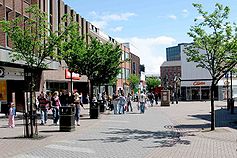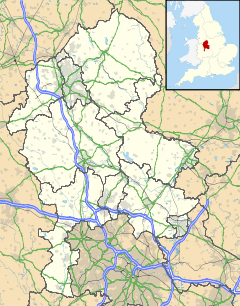- Hanley, Staffordshire
-
Coordinates: 53°01′29″N 2°10′22″W / 53.0246°N 2.1729°W
Hanley 
Central Hanley, looking south along Town Road showing (centre right) the statue of Stanley Matthews
 Hanley shown within Staffordshire
Hanley shown within StaffordshireOS grid reference SJ880480 Unitary authority Stoke-on-Trent Ceremonial county Staffordshire Region West Midlands Country England Sovereign state United Kingdom Post town STOKE-ON-TRENT Postcode district ST1 Dialling code 01782 Police Staffordshire Fire Staffordshire Ambulance West Midlands EU Parliament West Midlands UK Parliament Stoke-on-Trent Central List of places: UK • England • Staffordshire Hanley, in Staffordshire, England, is one of the six major towns that joined together to form the city of Stoke-on-Trent in 1910. Hanley was the only one of the six towns to be a county borough before the merger; its status was transferred to the enlarged borough. Hanley was incorporated as a municipal borough in 1857 and became a county borough with the passage of the Local Government Act 1888.
It now acts as the city's main city-centre and shopping centre, the principal attraction being the Potteries Shopping Centre containing many high street chain stores.
Contents
History
Etymology
The name Hanley comes from “haer lea”, meaning “high meadow”. or 'Heah Lea' meaning Rock Meadow
Garden Festival
The 1986 Stoke-on-Trent Garden Festival led to the reclamation of large areas of land west of the city centre area – including the former Shelton steelworks, which had been derelict since 1978. Ironically, when the Garden Festival closed, the land remained derelict for some time, before being re-developed partly into public parkland and partly for retail and leisure.
Coal mining
At one time, there were many coal mines in North Staffordshire. Hanley Deep Pit was opened in 1854. It was the deepest pit in the North Staffordshire coalfield, reaching a depth of 1500 feet. At its peak in the 1930s it employed some 2000 men and boys often producing 9000 tons of coal a year. The pit was closed in 1962 but much of the headgear and spoilheaps were left in situ. Then, in the 1980s, the original site was cleared, landscaped and converted into Hanley Forest Park.[1][2]
Public transport
Hanley has a bus station, on Lichfield Street, with local buses serving much of North Staffordshire, as well as Buxton, Crewe and Stafford. Most services are run by First PMT, though there are a number of smaller independent operators. In addition, National Express Coaches connect Hanley with destinations including London, Birmingham, Liverpool and Manchester, with additional seasonal services to holiday destinations. As part of the redevelopment of the town and wider city, a new bus interchange will be built on John Street, allowing the current station to be demolished to make room for further redevelopment of the town.
Hanley no longer has a railway station but there was once one located on Trinity Street, on the Potteries Loop Line, which was opened by the North Staffordshire Railway for passengers on July 13, 1864.[3] The station survived for 100 years – it was closed in 1964, as part of the Beeching Axe, and the land is now a car park.
Decline of name
On 1 April 1910, the town was federated into the county borough of Stoke-on-Trent. By 1925 the area was granted city status.
In recent years, there has been a notable decline in the use of the name of Hanley, owing to the town's increasing role as the city centre. Road signs on major roads into and around the city now refer to the area as 'City centre', although Hanley's name still appears on local road signs. Many documents published by local and national government also refer to the area as the city centre, as does public transport in the region.
In 2009,[4] the City Centre Partnership (a body promoting the development and re-generation of the city centre) proposed officially renaming the town centre (specifically, the area within the ring road) to Stoke-on-Trent City Centre, while keeping the Hanley name for the surrounding area. The Partnership is actively encouraging businesses in the area to remove the name of Hanley from their addresses, and have asked the city council to instruct the Ordnance Survey to refer to the area as the city centre, instead of Hanley.
The reasoning behind these proposals is that while Stoke-on-Trent has been federated for over 100 years, it is still polycentric. In other words, it has the characteristics of (at least) six overlapping towns, instead of a single city. The current situation can also be confusing for visitors to the city, who regularly end up in the town of Stoke-upon-Trent (which has renaming proposals of its own), thinking it is the city centre.
These trends and proposals have been met with opposition throughout the city. Residents of Hanley see them as a loss of the town's heritage,[5] while residents of the other towns in the city see them as promoting Hanley over their respective towns. However, Hanley still remains the main name in usage for this town; particularly in popular parlance, where the phrase "Up 'Anley duck" is a common local phrase describing going either shopping or for a night out;Hanley being the most common place people go to for these things.
Cultural sites
Hanley also offers several cultural facilities such as The Potteries Museum & Art Gallery (a large ceramics collection, and restored Spitfire), the Victoria Hall, the Regent Theatre, BBC Radio Stoke's Open Centre and studios, while Piccadilly hosts the annual Sanity Fair and French Market events. Hanley is also the location of Stoke Pride, an annual pride event for LGBT people of the city.
Religion
Christian Churches and Chapels in Hanley include: Bethesda Town Mission (Jasper Street), Congregational Independent Tabernacle Church (High Street), Elim Church (Bucknall Old Road corner of Mynors Street, Northwood), Etruria Wesleyan Chapel (Etruria Old Road, Etruria), Holy Trinity C of E (Lower Mayer Street, Northwood), Providence Methodist Church (Junction of Town Road, and Hulton Street), St. John's C of E (Town Road, Hanley), St. Luke's C of E (Wellington Terrace), St. Mark's C of E (Broad Street, Shelton), St. Matthew's C of E (Birches Head), Sacred Heart RC (Jasper Street), Trinity Methodist (Keelings Road, Northwood), and St Simon and St Jude (Seaford Street, College (was Victoria) Road, Shelton).
Hanley in old Trade Journals
"HANLEY a large modern town and chapelry, in the parish of Stoke, is about two miles east by north of Newcastle [under-Lyme], and ranks next to Burslem in size, extent and opulence. The town is in an elevated situation, and the streets forming which are irregular, but many of the houses are well built. The chapelry contained, in 1821, 5,622 inhabitants."
1828 journal
"Hanley, the most populous town in North Staffordshire, is generally described as the capital of the Potteries, a title to which it has certainly the greatest pretensions; ........ it has during the present century made such strides in the art, as to overtake and pass all competitors. At the census of 1891, the population of the municipal borough reached the total of 54,846; and such is the prosperity of the district, that at the present time this number has been very largely increased.
1893 journal
Notable people
- Terry Alcock, former professional footballer
- Arnold Bennett, novelist
- Stanley Matthews, former professional footballer
- Edward Smith, captain of the RMS Titanic
- Harold Perkin, social historian
See also
- Bethesda Methodist Chapel, Hanley
References
- ^ Pictures of Hanley Deep Pit
- ^ History of Hanley Deep Pit from local newspaper extracts
- ^ The North Staffordshire Railway Rex Christiansen & R. W. Miller. David & Charles Newton Abbot 1971 p. 79
- ^ Stoke-on-Trent City Centre Partnership Business Plan 2009-2010
- ^ Pits n Pots: Bid to get rid of Hanley
External links
- Hanley - one of the Six Towns
- The Potteries Museum & Art Gallery, Hanley
- Use interactive maps to find historic photographs and objects of old Hanley
- Town profile at The Sentinel (local newspaper)
Ceremonial county of Staffordshire Unitary authorities Boroughs or districts Major settlements Biddulph • Burntwood • Burton upon Trent • Cannock • Cheadle • Eccleshall • Fazeley • Hednesford • Kidsgrove • Leek • Lichfield • Newcastle-under-Lyme • Penkridge • Rugeley • Stafford • Stoke-on-Trent (Burslem • Fenton • Hanley • Longton • Stoke • Tunstall) • Stone • Tamworth • Uttoxeter • Wombourne
See also: List of civil parishes in StaffordshireRivers Canals Topics MuseumsCategories:- Areas of Stoke-on-Trent
- Towns in Staffordshire
Wikimedia Foundation. 2010.

